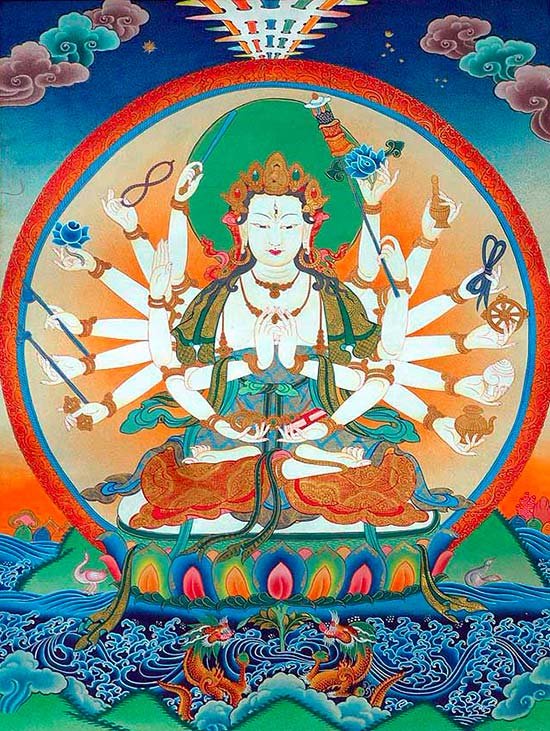Maha Prajnaparamita Sastra
by Gelongma Karma Migme Chödrön | 2001 | 941,039 words
This page describes “fourteen unanswered questions” as written by Nagarjuna in his Maha-prajnaparamita-sastra (lit. “the treatise on the great virtue of wisdom”) in the 2nd century. This book, written in five volumes, represents an encyclopedia on Buddhism as well as a commentary on the Pancavimsatisahasrika Prajnaparamita.
Appendix 8 - Fourteen unanswered questions
Note: these questions are dealt with in chapter IV part 14.
We know that the Buddha is not omniscient because he did not reply to fourteen difficult questions. What are these fourteen difficult questions?
(1–4) Are the world and the self eternal?
Are they non-eternal?
Are they both eternal and non-eternal?
Are they neither eternal nor non-eternal?(5–9) Are the world and the self finite?
Are they infinite?
Are they both finite and infinite?
Are they neither finite nor infinite?(9–12) Does the Tathāgata [or the saint freed from desire] exist after death?
Does he not exist after death?
Does he both exist and not exist after death?
Is it false that he both exists and does not exist after death?(13–14) Is the life-principle the same as the body?
Is the life-principle different from the body?
These fourteen difficult questions are often referred to in scholasticism by the term “Fourteen reserved or non-defined points” (caturdaśāvyākṛtavastūni). Cf. Madh. vṛtti, p. 446; Madh. avatāra, p. 250–251 (tr. LAV. Muséon, 1911, p. 297–298; Kośa, V, p. 43. The Pāli canon and the Chinese translation of the Madhyamāgama (T 26) list only ten reserved points.
(1–2) Sassato loko, asassato loko.
(3–4) Antavā loko, anatavā loko.
(5–6) Taṃ jīvaṃ taṃ sarīraṃ, aññaṃ jīvaṃ aññaṃ sarīraṃ.
(7–10) Hoti tathāgato paraṃ marāṇā,
na hoti tathāgato paraṃ maraṇā,
hoti ca na ca hoti tathāgato paraṃ maraṇā,
neva hoti na na hoti tathāgato paraṃ marāṇā.
This formula, the most frequent, occurs in Dīgha, I, p. 187–188; Majjhima, I, p. 157, 426, 484; Saṃyutta III, p. 213–216; III, p. 258; IV, p. 280. 391–392; V, p. 418. The same formula is repeated in Tchong a han, T 26 (no. 221), k. 60, p. 804b (corresponding to Majjhima, I, p. 426).
But most of the Chinese Nikāyas are already familiar with these fourteen points. As a general rule, when a Pāli sutta enumerates ten points only, the corresponding sūtra in the Chinese Saṃyukta counts fourteen: Tsa a han, T 99 (no. 962), k. 34, p. 245c (corresponds to Majjhima, I, p. 484); ibid., (no. 963), k. 34, p. 246 (corresponds to Saṃyutta, III, p. 258); ibid., (no. 968), k. 34, p. 248c (corresponds to Aṅguttara, V, p. 186); ibid., (no. 408), k. 16, p. 109a–b (corresponds to Saṃyutta, V, p. 418).
– The fourteen points are also in the abridged version of the Chinese Saṃyukta, T 100 (no. 196), k. 10. p. 445a; (no. 202), k. 11, p. 448c.
– The Chinese version of the Dīrgha also has sixteen points by adding two supplementary points to nos. 13 and 14 of the formula of fourteen points: Tch’ong a han, T 1 (no. 28), k. 17, p. 111a (corresponds to Dīgha, I, p. 187–188).
– As do all the treatises of scholasticism, the Mppś adopted the formula of fourteen points. A few rare texts (Dīgha, I, p. 16; III, p. 137; Majjhima, II, p. 233) modify the fourteen point formula by adding attā in front of the word loka that appears in the first eight points. Thus they say: sassato attā ca loka ca, asassato attā ca loka, etc.
– This modification has been adopted here by the Mppś.
– [There is an aberrant formula in the Chinese version of the Ekottara, Tseng yi a han, T 125, k. 43, p. 784b: Does the self exist? Does it not exist? Does it both exist and not exist? Is the world eternal? Is it non-eternal? Is the world finite? Is the world infinite? Is the soul the same thing as the body? Is it different from the body? Does the Tathāgata die? Does he not die? Is there death? Is there no death?]
The Buddha always declined answering these questions and some Indianists have used this as an excuse to present him as an agnostic. Some are even of the opinion that his agnosticism conceals a total nihilism: if the Buddha refused to provide a solution to the great problems that preoccupy humanity, it is because he had answered in the negative in petto. de La Vallée Poussin, who has always argued in favor of the blessed nirvāṇa, has put forth and discussed these interpretations in his article Agnoticisme, ERE, I, p. 220–225, and in his work, Nirvāṇa, Paris, 1923, p. 85–129. Probably early Buddhism, more preoccupied with asceticism than with metaphysics, did not ask these questions, but when they were raised in the course of time, it thought they could be evaded by condemning them as irrelevant and even dangerous under the pretext that they were not directed towards the discipline of salvation.
